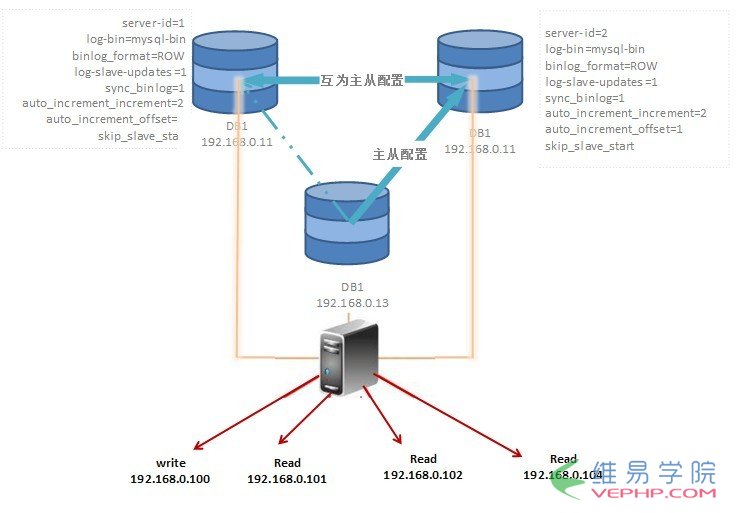Mysql必讀MySQL-MMM安裝指南(Multi-Master Replication Manager for MySQL)
《Mysql必讀MySQL-MMM安裝指南(Multi-Master Replication Manager for MySQL)》要點:
本文介紹了Mysql必讀MySQL-MMM安裝指南(Multi-Master Replication Manager for MySQL),希望對您有用。如果有疑問,可以聯系我們。
MYSQL教程最基本的MMM安裝必須至少需要2個數據庫服務器和一個監控服務器下面要配置的MySQL Cluster環境包含四臺數據庫服務器和一臺監控服務器,如下:
| function | ip | hostname | server id |
|---|---|---|---|
| monitoring host | 192.168.0.10 | mon | - |
| master 1 | 192.168.0.11 | db1 | 1 |
| master 2 | 192.168.0.12 | db2 | 2 |
| slave 1 | 192.168.0.13 | db3 | 3 |
| slave 2 | 192.168.0.14 | db4 | 4 |
MYSQL教程如果是個人學習安裝,一下子找5臺機器不太容易,可以虛擬機就可以完成.
MYSQL教程?配置完成后,使用下面的虛擬IP訪問MySQL Cluster,他們通過MMM分配到不同的服務器.
| ip | role | description |
|---|---|---|
| 192.168.0.100 | writer | 應用程序應該連接到這個ip進行寫操作 |
| 192.168.0.101 | reader | 應用程序應該鏈接到這些ip中的一個進行讀操作 |
| 192.168.0.102 | reader | |
| 192.168.0.103 | reader | |
| 192.168.0.104 | reader |
MYSQL教程結構圖如下:

MYSQL教程2. Basic configuration of master 1
First we install MySQL on all hosts:
aptitude install mysql-serverThen we edit the configuration file /etc/mysql/my.cnf and add the following lines - be sure to use different server ids for all hosts:
server_id = 1
log_bin = /var/log/mysql/mysql-bin.log
log_bin_index = /var/log/mysql/mysql-bin.log.index
relay_log = /var/log/mysql/mysql-relay-bin
relay_log_index = /var/log/mysql/mysql-relay-bin.index
expire_logs_days = 10
max_binlog_size = 100M
log_slave_updates = 1
Then remove the following entry:
bind-address = 127.0.0.1Set to number of masters:
auto_increment_increment = 2Set to a unique, incremented number, less than auto_increment_increment, on each server
auto_increment_offset = 1Do not bind of any specific IP, use 0.0.0.0 instead:
bind-address = 0.0.0.0Afterwards we need to restart MySQL for our changes to take effect:
/etc/init.d/mysql restart
3. Create usersNow we can create the required users. We'll need 3 different users:
| function | description | privileges |
|---|---|---|
| monitor user | used by the mmm monitor to check the health of the MySQL servers | REPLICATION CLIENT |
| agent user | used by the mmm agent to change read-only mode, replication master, etc. | SUPER, REPLICATION CLIENT, PROCESS |
| relication user | used for replication | REPLICATION SLAVE |
GRANT REPLICATION CLIENT???????????????? ON *.* TO 'mmm_monitor'@'192.168.0.%' IDENTIFIED BY 'monitor_password';
GRANT SUPER, REPLICATION CLIENT, PROCESS ON *.* TO 'mmm_agent'@'192.168.0.%'?? IDENTIFIED BY 'agent_password';
GRANT REPLICATION SLAVE????????????????? ON *.* TO 'replication'@'192.168.0.%' IDENTIFIED BY 'replication_password';
MYSQL教程Note: We could be more restrictive here regarding the hosts from which the users are allowed to connect: mmm_monitor is used from 192.168.0.10. mmm_agent and replication are used from 192.168.0.11 - 192.168.0.14.
Note: Don't use a replication_password longer than 32 characters
MYSQL教程4. Synchronisation of data between both databases
MYSQL教程I'll assume that db1 contains the correct data. If you have an empty database, you still have to syncronize the accounts we have just created.
First make sure that no one is altering the data while we create a backup.
(db1) mysql> FLUSH TABLES WITH READ LOCK;
MYSQL教程Then get the current position in the binary-log. We will need this values when we setup the replication on db2, db3 and db4.
(db1) mysql> SHOW MASTER STATUS;
+------------------+----------+--------------+------------------+
| File???????????? | Position | Binlog_Do_DB | Binlog_Ignore_DB |
+------------------+----------+--------------+------------------+
| mysql-bin.000002 |????? 374 |????????????? |????????????????? |
+------------------+----------+--------------+------------------+
1 row in set (0.00 sec)
MYSQL教程DON'T CLOSE this mysql-shell. If you close it, the database lock will be removed. Open a second console and type:
MYSQL教程db1$ mysqldump -u root -p --all-databases > /tmp/database-backup.sql
MYSQL教程Now we can remove the database-lock. Go to the first shell:
MYSQL教程(db1) mysql> UNLOCK TABLES;Copy the database backup to db2, db3 and db4.
db1$ scp /tmp/database-backup.sql <user>@192.168.0.12:/tmp
db1$ scp /tmp/database-backup.sql <user>@192.168.0.13:/tmp
db1$ scp /tmp/database-backup.sql <user>@192.168.0.14:/tmp
MYSQL教程Then import this into db2, db3 and db4:
db2$ mysql -u root -p < /tmp/database-backup.sql
db3$ mysql -u root -p < /tmp/database-backup.sql
db4$ mysql -u root -p < /tmp/database-backup.sql
MYSQL教程Then flush the privileges on db2, db3 and db4. We have altered the user-table and mysql has to reread this table.
(db2) mysql> FLUSH PRIVILEGES;
(db3) mysql> FLUSH PRIVILEGES;
(db4) mysql> FLUSH PRIVILEGES;
MYSQL教程On debian and ubuntu, copy the passwords in /etc/mysql/debian.cnf from db1 to db2, db3 and db4. This password is used for starting and stopping mysql.
Both databases now contain the same data. We now can setup replication to keep it that way.
Note: Import just only add records from dump file. You should drop all databases before import dump file.
MYSQL教程5. Setup replication
MYSQL教程Configure replication on db2, db3 and db4 with the following commands:
(db2) mysql> CHANGE MASTER TO master_host='192.168.0.11', master_port=3306, master_user='replication',
????????????? master_password='replication_password', master_log_file='<file>', master_log_pos=<position>;
(db3) mysql> CHANGE MASTER TO master_host='192.168.0.11', master_port=3306, master_user='replication',
????????????? master_password='replication_password', master_log_file='<file>', master_log_pos=<position>;
(db4) mysql> CHANGE MASTER TO master_host='192.168.0.11', master_port=3306, master_user='replication',
????????????? master_password='replication_password', master_log_file='<file>', master_log_pos=<position>;
MYSQL教程Please insert the values return by “show master status” on db1 at the <file> and <position> tags.
Start the slave-process on all 3 hosts:
(db2) mysql> START SLAVE;
(db3) mysql> START SLAVE;
(db4) mysql> START SLAVE;
MYSQL教程Now check if the replication is running correctly on all hosts:
(db2) mysql> SHOW SLAVE STATUS\G
*************************** 1. row ***************************
???????????? Slave_IO_State: Waiting for master to send event
??????????????? Master_Host: 192.168.0.11
??????????????? Master_User: replication
??????????????? Master_Port: 3306
????????????? Connect_Retry: 60
…
(db3) mysql> SHOW SLAVE STATUS\G
*************************** 1. row ***************************
???????????? Slave_IO_State: Waiting for master to send event
??????????????? Master_Host: 192.168.0.11
??????????????? Master_User: replication
??????????????? Master_Port: 3306
????????????? Connect_Retry: 60
…
(db4) mysql> SHOW SLAVE STATUS\G
*************************** 1. row ***************************
???????????? Slave_IO_State: Waiting for master to send event
??????????????? Master_Host: 192.168.0.11
??????????????? Master_User: replication
??????????????? Master_Port: 3306
????????????? Connect_Retry: 60
…
MYSQL教程Now we have to make db1 replicate from db2. First we have to determine the values for master_log_file and master_log_pos:
(db2) mysql> SHOW MASTER STATUS;
+------------------+----------+--------------+------------------+
| File???????????? | Position | Binlog_Do_DB | Binlog_Ignore_DB |
+------------------+----------+--------------+------------------+
| mysql-bin.000001 |?????? 98 |????????????? |????????????????? |
+------------------+----------+--------------+------------------+
1 row in set (0.00 sec)
MYSQL教程Now we configure replication on db1 with the following command:
(db1) mysql> CHANGE MASTER TO master_host = '192.168.0.12', master_port=3306, master_user='replication',
????????????? master_password='replication_password', master_log_file='<file>', master_log_pos=<position>;
MYSQL教程Now insert the values return by “show master status” on db2 at the <file> and <position> tags.
MYSQL教程Start the slave-process:
MYSQL教程(db1) mysql> START SLAVE;Now check if the replication is running correctly on db1:
(db1) mysql> SHOW SLAVE STATUS\G
*************************** 1. row ***************************
???????????? Slave_IO_State: Waiting for master to send event
??????????????? Master_Host: 192.168.0.12
??????????????? Master_User: <replication>
??????????????? Master_Port: 3306
????????????? Connect_Retry: 60
…
MYSQL教程Replication between the nodes should now be complete. Try it by inserting some data into both db1 and db2 and check that the data will appear on all other nodes.
MYSQL教程6. Install MMM
MYSQL教程Create user
Optional: Create user that will be the owner of the MMM scripts and configuration files. This will provide an easier method to securely manage the monitor scripts.
MYSQL教程useradd --comment "MMM Script owner" --shell /sbin/nologin mmmdMonitoring host
First install dependencies:
aptitude install liblog-log4perl-perl libmailtools-perl liblog-dispatch-perl libclass-singleton-perl libproc-daemon-perl libalgorithm-diff-perl libdbi-perl libdbd-mysql-perl
MYSQL教程Then fetch the latest mysql-mmm-common*.deb and mysql-mmm-monitor*.deb and install it:
MYSQL教程dpkg -i mysql-mmm-common_*.deb mysql-mmm-monitor*.deb
MYSQL教程Database hosts
On Ubuntu First install dependencies:
MYSQL教程aptitude install liblog-log4perl-perl libmailtools-perl liblog-dispatch-perl iproute libnet-arp-perl libproc-daemon-perl libalgorithm-diff-perl libdbi-perl libdbd-mysql-perlThen fetch the latest mysql-mmm-common*.deb and mysql-mmm-agent*.deb and install it:
MYSQL教程dpkg -i mysql-mmm-common_*.deb mysql-mmm-agent_*.debOn RedHat
MYSQL教程yum install -y mysql-mmm-agentThis will take care of all the dependencies, which may include:
MYSQL教程Installed:
MYSQL教程mysql-mmm-agent.noarch 0:2.2.1-1.el5
MYSQL教程Dependency Installed:
libart_lgpl.x86_64 0:2.3.17-4????????????????????????????????????????????????
mysql-mmm.noarch 0:2.2.1-1.el5???????????????????????????????????????????????
perl-Algorithm-Diff.noarch 0:1.1902-2.el5????????????????????????????????????
perl-DBD-mysql.x86_64 0:4.008-1.rf???????????????????????????????????????????
perl-DateManip.noarch 0:5.44-1.2.1???????????????????????????????????????????
perl-IPC-Shareable.noarch 0:0.60-3.el5???????????????????????????????????????
perl-Log-Dispatch.noarch 0:2.20-1.el5????????????????????????????????????????
perl-Log-Dispatch-FileRotate.noarch 0:1.16-1.el5?????????????????????????????
perl-Log-Log4perl.noarch 0:1.13-2.el5????????????????????????????????????????
perl-MIME-Lite.noarch 0:3.01-5.el5???????????????????????????????????????????
perl-Mail-Sender.noarch 0:0.8.13-2.el5.1?????????????????????????????????????
perl-Mail-Sendmail.noarch 0:0.79-9.el5.1?????????????????????????????????????
perl-MailTools.noarch 0:1.77-1.el5???????????????????????????????????????????
perl-Net-ARP.x86_64 0:1.0.6-2.1.el5??????????????????????????????????????????
perl-Params-Validate.x86_64 0:0.88-3.el5?????????????????????????????????????
perl-Proc-Daemon.noarch 0:0.03-1.el5?????????????????????????????????????????
perl-TimeDate.noarch 1:1.16-5.el5????????????????????????????????????????????
perl-XML-DOM.noarch 0:1.44-2.el5?????????????????????????????????????????????
perl-XML-Parser.x86_64 0:2.34-6.1.2.2.1??????????????????????????????????????
perl-XML-RegExp.noarch 0:0.03-2.el5??????????????????????????????????????????
rrdtool.x86_64 0:1.2.27-3.el5????????????????????????????????????????????????
rrdtool-perl.x86_64 0:1.2.27-3.el5
MYSQL教程Configure MMM
MYSQL教程All generic configuration-options are grouped in a separate file called /etc/mysql-mmm/mmm_common.conf. This file will be the same on all hosts in the system:
active_master_role????????? writer
MYSQL教程<host default>
??? cluster_interface?????? eth0
??? pid_path??????????????? /var/run/mmmd_agent.pid
??? bin_path??????????????? /usr/lib/mysql-mmm/
??? replication_user??????? replication
??? replication_password??? replication_password
??? agent_user????????????? mmm_agent
??? agent_password????????? agent_password
</host>
<host db1>
??? ip????????????????????? 192.168.0.11
??? mode??????????????????? master
??? peer??????????????????? db2
</host>
<host db2>
??? ip????????????????????? 192.168.0.12
??? mode??????????????????? master
??? peer??????????????????? db1
</host>
<host db3>
??? ip????????????????????? 192.168.0.13
??? mode??????????????????? slave
</host>
<host db4>
??? ip????????????????????? 192.168.0.14
??? mode??????????????????? slave
</host>
MYSQL教程<role writer>
??? hosts?????????????????? db1, db2
??? ips???????????????????? 192.168.0.100
??? mode??????????????????? exclusive
</role>
<role reader>
??? hosts?????????????????? db1, db2, db3, db4
??? ips???????????????????? 192.168.0.101, 192.168.0.102, 192.168.0.103, 192.168.0.104
??? mode??????????????????? balanced
</role>
MYSQL教程Don't forget to copy this file to all other hosts (including the monitoring host).
MYSQL教程On the database hosts we need to edit /etc/mysql-mmm/mmm_agent.conf. Change “db1” accordingly on the other hosts:
include mmm_common.conf
this db1
MYSQL教程On the monitor host we need to edit /etc/mysql-mmm/mmm_mon.conf:
include mmm_common.conf
MYSQL教程<monitor>
??? ip????????????????????? 127.0.0.1
??? pid_path??????????????? /var/run/mmmd_mon.pid
??? bin_path??????????????? /usr/lib/mysql-mmm/
??? status_path???????????? /var/lib/misc/mmmd_mon.status
??? ping_ips??????????????? 192.168.0.1, 192.168.0.11, 192.168.0.12, 192.168.0.13, 192.168.0.14
</monitor>
MYSQL教程<host default>
??? monitor_user??????????? mmm_monitor
??? monitor_password??????? monitor_password
</host>
MYSQL教程debug 0
MYSQL教程ping_ips are some ips that are pinged to determine whether the network connection of the monitor is ok. I used my switch (192.168.0.1) and the four database server.
MYSQL教程
7. Start MMM
MYSQL教程?
MYSQL教程Start the agents
(On the database hosts)
MYSQL教程Debian/Ubuntu
Edit /etc/default/mysql-mmm-agent to enable the agent:
MYSQL教程ENABLED=1Red Hat
RHEL/Fedora does not enable packages to start at boot time per default policy, so you might have to turn it on manually so the agents will start automatically when server is rebooted:
MYSQL教程chkconfig mysql-mmm-agent onThen start it:
MYSQL教程/etc/init.d/mysql-mmm-agent startStart the monitor
(On the monitoring host) Edit /etc/default/mysql-mmm-monitor to enable the monitor:
MYSQL教程ENABLED=1Then start it:
MYSQL教程/etc/init.d/mysql-mmm-monitor start
MYSQL教程Wait some seconds for mmmd_mon to start up. After a few seconds you can use mmm_control to check the status of the cluster:
mon$ mmm_control show
? db1(192.168.0.11) master/AWAITING_RECOVERY. Roles:
? db2(192.168.0.12) master/AWAITING_RECOVERY. Roles:
? db3(192.168.0.13) slave/AWAITING_RECOVERY. Roles:
? db4(192.168.0.14) slave/AWAITING_RECOVERY. Roles:
MYSQL教程Because its the first startup the monitor does not know our hosts, so it sets all hosts to state AWAITING_RECOVERY and logs a warning message:
mon$ tail /var/log/mysql-mmm/mmm_mon.warn
…
2009/10/28 23:15:28? WARN Detected new host 'db1': Setting its initial state to 'AWAITING_RECOVERY'. Use 'mmm_control set_online db1' to switch it online.
2009/10/28 23:15:28? WARN Detected new host 'db2': Setting its initial state to 'AWAITING_RECOVERY'. Use 'mmm_control set_online db2' to switch it online.
2009/10/28 23:15:28? WARN Detected new host 'db3': Setting its initial state to 'AWAITING_RECOVERY'. Use 'mmm_control set_online db3' to switch it online.
2009/10/28 23:15:28? WARN Detected new host 'db4': Setting its initial state to 'AWAITING_RECOVERY'. Use 'mmm_control set_online db4' to switch it online.
MYSQL教程Now we set or hosts online (db1 first, because the slaves replicate from this host):
mon$ mmm_control set_online db1
OK: State of 'db1' changed to ONLINE. Now you can wait some time and check its new roles!
mon$ mmm_control set_online db2
OK: State of 'db2' changed to ONLINE. Now you can wait some time and check its new roles!
mon$ mmm_control set_online db3
OK: State of 'db3' changed to ONLINE. Now you can wait some time and check its new roles!
mon$ mmm_control set_online db4
OK: State of 'db4' changed to ONLINE. Now you can wait some time and check its new roles!
MYSQL教程參考:http://mysql-mmm.org/mmm2:guide
轉載請注明本頁網址:
http://www.snjht.com/jiaocheng/2047.html
同類教程排行
- Mysql實例mysql報錯:Deadl
- MYSQL數據庫mysql導入sql文件
- MYSQL的UTF8MB4編碼排序要用u
- MYSQL教程mysql自定義split
- 如何打造MySQL高可用平臺
- MYSQL創建表出錯Tablespace
- Mysql必讀MySQL中CLIENT_
- MYSQL數據庫mysql常用字典表(完
- Mysql應用MySql的Communi
- Mysql入門解決MySQL Sendi
- Mysql必讀關于skip_name_r
- MYSQL數據庫MySQL實現兩張表數據
- Mysql實例使用dreamhost空間
- MYSQL數據庫mysql 查詢表中平均
- MYSQL教程mysql 跨表查詢、更新
